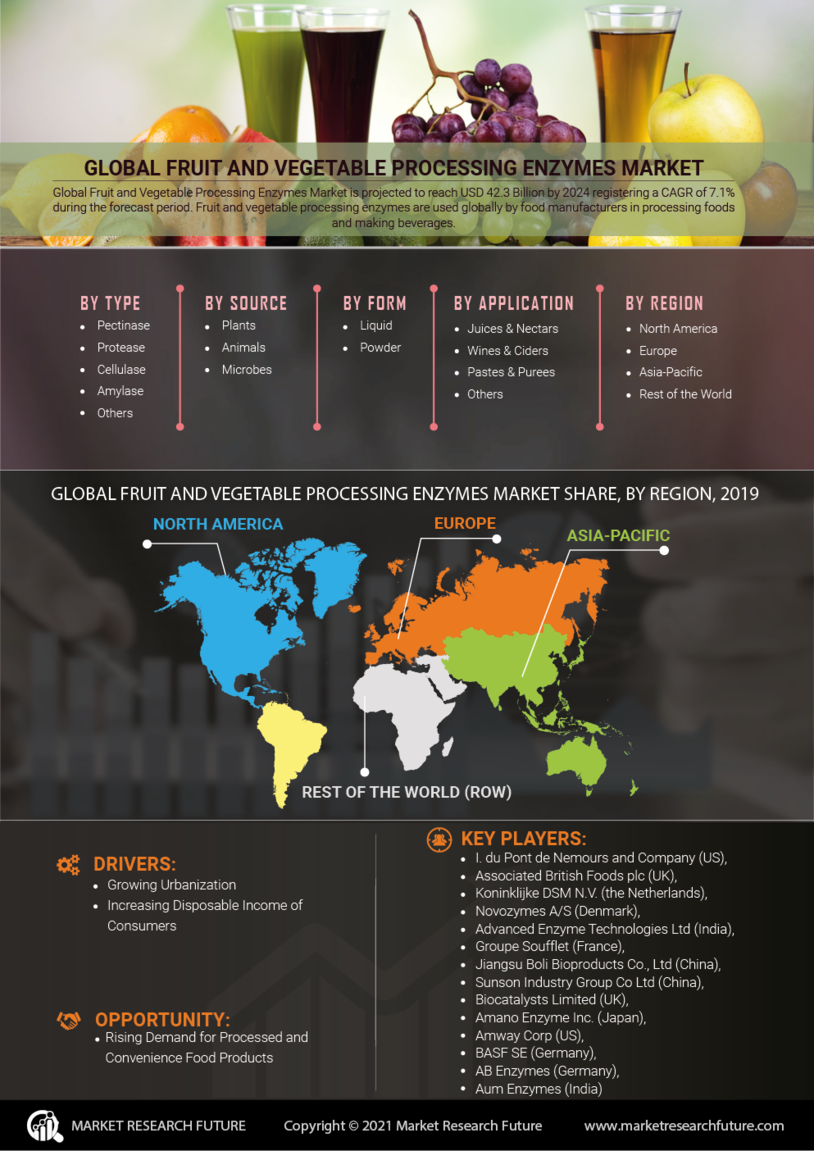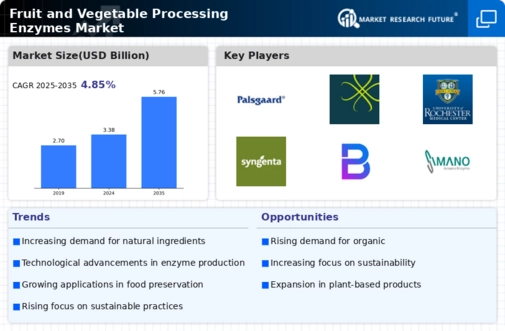Market Growth Projections
The Global Fruit and Vegetable Processing Enzymes Market Industry is projected to experience substantial growth, with market value expected to reach 5.76 USD Billion by 2035. This growth trajectory indicates a strong demand for enzymes in food processing, driven by various factors such as health consciousness, technological advancements, and sustainability initiatives. The compound annual growth rate of 4.97% from 2025 to 2035 suggests a robust market environment, where innovations in enzyme applications will likely play a crucial role. As the industry adapts to changing consumer preferences and regulatory landscapes, the future appears promising for enzyme manufacturers and users alike.
Rising Demand for Processed Foods
The Global Fruit and Vegetable Processing Enzymes Market Industry experiences a notable surge in demand for processed foods, driven by changing consumer lifestyles and preferences. As urbanization continues to rise, consumers increasingly seek convenient and ready-to-eat food options. This trend is reflected in the projected market value of 3.38 USD Billion in 2024, indicating a robust growth trajectory. The incorporation of enzymes in processing enhances the quality and shelf life of products, making them more appealing to consumers. Consequently, manufacturers are investing in enzyme technologies to meet this growing demand, thereby propelling the market forward.
Health Consciousness Among Consumers
The increasing health consciousness among consumers significantly influences the Global Fruit and Vegetable Processing Enzymes Market Industry. As individuals become more aware of the nutritional benefits of fruits and vegetables, there is a growing preference for products that retain their natural qualities. Enzymes play a crucial role in preserving the nutritional value and enhancing the digestibility of processed foods. This shift towards healthier options is expected to contribute to the market's growth, as manufacturers seek to incorporate enzymes that align with consumer preferences for clean label products. The focus on health and wellness is likely to drive innovation in enzyme applications.
Regulatory Support for Enzyme Applications
Regulatory support for enzyme applications in the food industry positively impacts the Global Fruit and Vegetable Processing Enzymes Market Industry. Governments and regulatory bodies are increasingly recognizing the benefits of enzymes in food processing, leading to the establishment of guidelines that promote their safe use. This regulatory framework not only encourages innovation but also instills consumer confidence in enzyme-treated products. As the market evolves, the alignment of regulatory policies with industry practices is expected to facilitate growth. The anticipated market value of 5.76 USD Billion by 2035 underscores the potential for continued expansion driven by supportive regulations.
Sustainability Initiatives in Food Processing
Sustainability initiatives are increasingly shaping the Global Fruit and Vegetable Processing Enzymes Market Industry, as both consumers and manufacturers prioritize environmentally friendly practices. The use of enzymes in food processing can reduce waste and energy consumption, aligning with global sustainability goals. For instance, enzymes can facilitate the extraction of juice from fruits and vegetables, minimizing waste and maximizing yield. As sustainability becomes a key consideration in food production, the demand for enzymes that support eco-friendly practices is likely to rise. This trend may further enhance the market's growth potential, as companies strive to meet consumer expectations for sustainable products.
Technological Advancements in Enzyme Production
Technological advancements play a pivotal role in the Global Fruit and Vegetable Processing Enzymes Market Industry, as innovations in enzyme production and application enhance efficiency and effectiveness. The development of recombinant DNA technology and fermentation processes allows for the production of high-purity enzymes, which are essential for various processing applications. These advancements not only improve the yield and functionality of enzymes but also reduce production costs. As a result, the market is expected to witness a compound annual growth rate of 4.97% from 2025 to 2035, reflecting the industry's adaptability to new technologies and processes.




















Leave a Comment